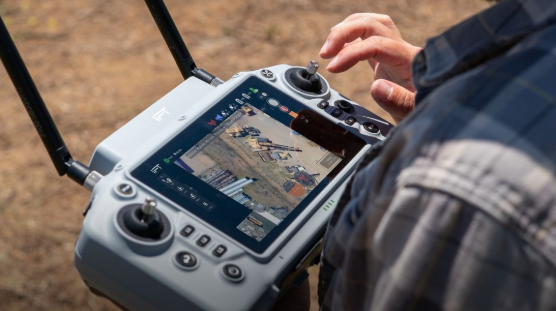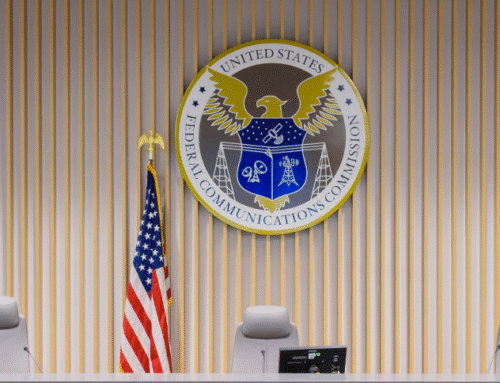You love flying drones. But if you’re in enterprise, public safety, or defense, you know the struggle: unreliable controllers, dim screens, and banned foreign tech. No more compromises. Inspired Flight Technologies has launched the GS-ONE Ground Control Station, a handheld drone controller that promises to change your missions for the better. This rugged, American-made device comes packed with cutting-edge specs and is fully compliant with U.S. government requirements. It’s not a drone itself – it’s the controller – yet it might be the most exciting thing to hit the UAS market in 2025.
Why GS-ONE Matters
Let’s talk about why this launch is such a big deal right now.
In recent years, U.S. companies and government agencies have faced severe limitations on using foreign-made drone tech. Several states (Florida, Arkansas, Texas, Mississippi, and more) have banned their agencies from buying or using drones with Chinese components. Federal departments like the DoD and DOI have grounded Chinese drones over data security fears. Even buying new DJI flagship drones like the Mavic 4 Pro in the U.S. is difficult due to trade restrictions and an impending federal ban review.
Related Reading: Tariffs, Trade Wars, and Drone Users Caught In The Middle
The U.S. drone market, valued around $10.9 billion in 2024, is rapidly shifting toward trusted domestic solutions. That’s where Inspired Flight fits in.
Inspired Flight Technologies is a San Luis Obispo, CA-based company known for its NDAA-compliant drones, meaning they contain no restricted Chinese parts. Their heavy-lift IF1200A and mid-sized IF800 Tomcat drones have already earned Blue UAS and Green UAS certifications (U.S. military and industry standards for trusted drones). By introducing the GS-ONE controller, Inspired Flight isn’t just selling you another gadget – it’s filling a critical gap.
Until now, many American drone operators had to rely on either repurposed tablet-based controllers or foreign-made “smart” controllers. Now you have an all-American option that meets government compliance straight out of the box. This is a huge milestone for industries like defense, utilities, and public safety that demand secure, domestically supported gear.
What The GS-ONE Brings To Field Operations
The GS-ONE Ground Control Station is a handheld controller designed for mission-critical field use. It’s not an off-the-shelf tablet with a joystick bolted on; it’s purpose-built from the ground up. Inspired Flight developed GS-ONE with direct feedback from drone operators in the field, and it shows in every detail.
Who is it for?
If you’re flying drones for commercial inspections, mapping, search-and-rescue, law enforcement, or military missions, GS-ONE was made for you. It’s fully integrated with Inspired Flight’s own drones – notably the IF800 Tomcat quadcopter and IF1200 hexacopter – ensuring a seamless link between pilot and aircraft. But it can also run third-party UAV apps, making it versatile for other platforms. From utility corridor inspections to disaster response, this controller aims to be your reliable command center in the field.
NDAA compliance is a core feature. Every component of GS-ONE’s radio and system adheres to U.S. government requirements. That gives agencies confidence that using this controller won’t introduce security risks or procurement headaches. At a time when “Made in USA” is more than a patriotic slogan – it’s a requirement for many drone programs – GS-ONE checks that box.
Let’s break down what makes the GS-ONE special, from its hardware to its real-world performance.
Bright, Glove-Friendly Touchscreen
The first thing you’ll notice is the display.
GS-ONE sports a 7-inch touchscreen that’s glove-compatible – yes, you can tap and swipe even with work gloves on. And the screen is extremely bright: 2,000 nits of brightness. What does that number mean for you? Basically, it’s four times brighter than a typical smartphone screen and even beats many other drone controllers. Pilots often struggle to see maps or video feeds on sunny days, but with 2000 cd/m², GS-ONE stays visible under direct sunlight. You won’t be hunching under a shade or guessing what’s on your display.
The resolution is a crisp 1080p, so your drone’s camera feed and telemetry will look sharp. Whether you’re inspecting a powerline or surveilling a scene, that clarity matters. Operators praise this feature – after all, a screen you can’t see is useless. In all seriousness, sunlight readability is core to field ops. The GS-ONE’s screen ensures you won’t be squinting at critical data when every second counts.
Rugged and Ready for Harsh Environments
Field operations can be brutal on gear. Inspired Flight clearly understood that, because GS-ONE is built like a tank (without the excess weight). The controller’s enclosure carries an IP55 rating, meaning it’s dust-proof and can handle low-pressure water jets – in plain terms, it’s rain-resistant and dirt-resistant.
Flying in a windy desert? Dust won’t stop it. Caught in a downpour during a search-and-rescue? GS-ONE can shrug off the rain. It’s also designed to handle a wide temperature range and rough handling. In fact, the device meets MIL-STD ruggedness in many aspects (Inspired Flight calls it a “MIL-grade build”), implying it has been tested against vibration, shock, and perhaps extreme temps for reliability.
Despite the durability, it’s still portable enough. The unit weighs about 3.9 pounds (1.8 kg) with its battery. That’s roughly the weight of a pro DSLR camera – solid but not unmanageable. Its form factor is about 11.3 x 7.0 x 3.2 inches, with handles and thumb sticks placed for a comfortable grip.
Several programmable buttons (nine of them) line the device for quick actions. You can customize these buttons for things like triggering the camera, dropping a pin on the map, or any function you need on the fly. For example, one button can instantly mark a geolocation (thanks to the controller’s built-in GPS) so you can tag points of interest or hazards with one press. It’s a thoughtful feature when you’re multitasking during a mission.
This controller is meant for the field. Be it a construction site, in a thick wildfire smoke zone, or perched on a windy hill inspecting a cell tower – GS-ONE is designed to keep working in all those scenarios. No delicate parts, no exposed electronics, and an external design that’s easy to wipe down after muddy or smoky jobs.
All-Day Battery Life with Hot-Swap Power
Nothing’s worse than your controller dying before the mission is over. GS-ONE attacks that problem with hot-swappable batteries that keep you running through long operations. Each battery pack provides up to 4–5 hours of continuous runtime. The controller only needs one battery at a time, and you can swap in a fresh one without powering down (the unit likely has an internal bridge battery to cover the few seconds during a swap). Inspired Flight advertises “up to 5 hours” on a pack, which is plenty for most flights – but since you can swap, you effectively have unlimited endurance as long as you have spare packs charged.
Swapping is tool-free and quick. The batteries slide in/out easily, which matters if you’re doing it in the field with sweaty hands or gloves. And charging them isn’t a pain either: GS-ONE supports USB-C Power Delivery fast charging, juicing a battery to full in under 3 hours. Many drone teams already carry USB-C PD chargers for other gear, so this fits right in.
If you compare that to other controllers: DJI’s enterprise controller (RC Plus) also offers ~6 hours with an external battery, and Autel’s smart controller gives ~4.5 hours. GS-ONE is in the same league, which is impressive given it’s driving a brighter screen than most. No more midday shutdowns. With GS-ONE, you can fly drones all morning and afternoon – swap a battery at lunch – and keep going into an overtime operation if needed. For public safety users in particular, who might be out on a search mission for 8+ hours, this is a lifesaver. You won’t be tethered to a generator or stuck in a vehicle waiting for a controller to charge. As one might say, battery anxiety be gone!
Rock-Solid Radio Link and Connectivity
Controllers are your lifeline to the drone. GS-ONE’s lifeline is built on a robust, NDAA-compliant 2.4 GHz radio link with some serious range. Officially, it offers up to 6 miles of range to the drone. That’s about 10 kilometers. In real-world terms, that easily covers typical beyond-visual-line-of-sight (BVLOS) missions like pipeline inspections or large-area mapping (with proper approvals, of course). Keep in mind, 6 miles is under ideal conditions. You’ll get a more conservative 4 km (2.5 mi) HD video link range in tougher conditions, but even that is plenty for most operations. The bottom line is you won’t outfly this controller’s signal before the drone’s battery runs out.
What’s special is that all this range comes without any Chinese parts or firmware – the radio module is NDAA compliant and likely uses technology vetted for U.S. government use. That’s a big reassurance if you work in defense or critical infrastructure. The GS-ONE’s radio maintains a steady link for telemetry and live video, so you get real-time feedback from your aircraft as far as legally allowed.
Beyond the direct radio, GS-ONE is loaded with connectivity options. It has built-in 4G LTE (Category 7 modem) for cellular connectivity. Why would you want cellular on a drone controller? Say you’re running remote operations – you can pipe telemetry through LTE to a cloud system or even control a drone over a cellular network (with the right software) from hundreds of miles away. Inspired Flight hints that GS-ONE is a “cloud-connected command center in your hands”. With LTE, the controller itself can send data back to headquarters or pull in live map updates without needing a tethered phone or external hotspot. It’s a forward-looking feature as drone programs increasingly use cloud platforms for fleet management and data streaming.
Related Reading: 14 Best Long Range UAVs with Infrared Imaging Systems
Then there’s Wi-Fi 6 and Bluetooth 5.2 on board. Wi-Fi is great for quickly offloading data or maybe for running the controller as a ground hotspot for other team members. Bluetooth 5.2 allows connecting wireless peripherals (maybe a headset for audio alerts, or an external keyboard if you really wanted). The versatile I/O ports include full-size HDMI, Ethernet (RJ-45), USB-A and USB-C, audio jack, plus microSD and SIM slots. Basically, GS-ONE can hook up to just about anything: want to output the live drone video to a big monitor at the command post? Plug into the HDMI port on GS-ONE. Need to connect to a wired network or a specialized device? Use Ethernet or USB. This is far beyond the limited ports on typical consumer controllers (many of which have only one micro USB or so). It shows the GS-ONE is designed as an integrated hub for drone ops, not just a remote.
Importantly, GS-ONE also has onboard GNSS (GPS/GLONASS etc.). That means the controller knows its own location, which can be stamped on your mission data and used for geolocation features. For example, if you mark a point-of-interest with the controller, it knows the coordinates relative to you. This can improve things like “home location” accuracy or sharing target coordinates with others on your team.
All this connectivity ensures that wherever your mission takes you – mountainous terrain, urban jungle, or remote farmland – the GS-ONE keeps you connected. If the direct radio link is limited by line-of-sight, you have the backup option of leveraging LTE (with the right software) for beyond-line-of-sight control. In fact, competitors like Skydio are doing something similar with their newest systems, combining direct radio with 5G links for “unlimited range” control via the cloud. Inspired Flight is clearly keeping pace with those trends, packing enterprise-grade comms into GS-ONE.
Brainpower: Android 14 and Qualcomm Inside
Under the hood, GS-ONE is as smart as a modern smartphone. It runs Android 14 on a Qualcomm QCS6490 processor. This processor is a 6-core or 8-core SoC optimized for IoT and drone applications, and it brings plenty of horsepower to the table. With 8 GB of RAM and 128 GB of internal storage, the GS-ONE can run complex apps and even store large maps or offline data. For perspective, that’s double the storage of DJI’s RC Plus controller and on par with Autel’s high-end controller. So you won’t run out of space saving flight logs, maps, or a few hours of video recording if needed.
The use of Android 14 means you can install and use third-party apps just like on a tablet. Inspired Flight ships it with their own Inspired Ground Control (IGC) software, which is built on the open-source QGroundControl project. IGC provides the flight interface, maps, mission planning, etc., tailored for their drones (with a clean UI and things like secure pilot login for accountability). But you’re not locked down – if your workflow uses apps like UGCS, DroneDeploy, Pix4D, or QGroundControl itself, you can run them on GS-ONE. This is huge for flexibility. Many enterprise users have specific software for tasks (e.g., a power utility might use an app for powerline inspection waypoints, or a police department might use a streaming app to send video to a command center). With GS-ONE, you can likely load those tools directly. It’s like having a hardened tablet that’s already connected to your drone.
Using a modern Android OS is a smart move. It future-proofs the device, as new apps or integrations can be developed for it just like any Android device, and updates from Google can keep it secure. So not only is GS-ONE tough and powerful now, it can stay relevant years down the line with software updates and new features (perhaps we’ll see custom plugins or AI assistants running on the controller – who knows!).
Industry Applications: From Utilities to Defense
So what can you do with the GS-ONE? Inspired Flight explicitly targets a few key industries and use cases:
- Critical Infrastructure Inspection: Think powerline and pipeline inspections, telecom tower surveys, railway and bridge inspections. These jobs often mean long flights beyond visual line of sight and in challenging RF environments. GS-ONE’s long-range link (6 miles) and high-brightness screen are perfect here. For example, if you’re inspecting a solar farm at noon, you’ll still see every panel clearly on your display. The rugged build means dust or drizzle on a wind farm won’t faze it.
- Utilities and Energy: Utility crews can use GS-ONE with Inspired Flight drones to check transmission lines, wind turbines, or oil and gas facilities. The controller’s 5-hour battery life and hot-swap let a crew run extended missions along a pipeline, landing the drone to change its battery while the controller keeps running. And with that HDMI output, they could even display the live feed on a large monitor at a mobile command van for multiple engineers to review in real time.
- Public Safety and Emergency Response: Police departments, fire departments, and search-and-rescue teams are going to love this controller. Take a firefighter drone unit monitoring a wildfire for instance– they’re in smoke, bright sun, and high stress. The glove-compatible controls and screen mean they don’t waste time taking gloves on and off. The IP55 ruggedness means if ash or water hoses spray the controller, it survives. Public safety drones often use thermal cameras; with GS-ONE’s high-res screen, an officer can identify a missing person or a hotspot more easily. And since many states now require NDAA-compliant gear for agencies, GS-ONE opens the door for agencies that have been grounding their DJI gear to get back in the sky legally.
- Defense and Security: This is a domain where Inspired Flight already has footing (their drones have been tested for military use). The GS-ONE clearly appeals to defense users: it’s American-made, secure, and works in tough conditions. Whether it’s an Army unit using drones for reconnaissance or a security contractor doing overwatch, the controller provides a secure link and a portable command station. The 2.4 GHz link is likely encrypted and resistant to jamming (though not explicitly stated, NDAA compliance often goes hand-in-hand with using robust comms like AES encryption and frequency hopping). Also, since it runs Android, specialized defense apps (for targeting, mapping, etc.) could be run on it. For night operations, the screen can probably dim significantly or use a night mode, although we only talk about how bright it gets!
Related Reading: How the DoD is Fighting Threats From Enemy Drones
- Mapping and Surveying: Surveyors and mappers who use drones for creating maps, 3D models, or LiDAR scans will find GS-ONE useful too. They often operate in open areas under the sun – again that display is a plus. Also, mapping flights are mostly pre-planned waypoint missions. The Inspired Ground Control app provides waypoint and grid planning with 3D previews. Doing that on a 7-inch device with responsive performance is much easier than on a tiny phone or clunky laptop outdoors. After flights, they could take the microSD card out with all the logs or imagery and transfer to processing software.
- Enterprise Drone Programs: Beyond specific industries, any large enterprise with a drone program (construction firms, surveying companies, agriculture, etc.) will appreciate the fleet management integration. Inspired Flight has an ecosystem called Inspired Suite that includes cloud tools for fleet oversight and pilot management. GS-ONE would sync with these tools (via LTE or Wi-Fi), uploading flight data to a central database. For example, a utility company’s drone team lead could see in real time that a crew’s GS-ONE is out inspecting a line, their flight path, battery status, etc., remotely via the cloud. It’s all about bridging the field and the office.
In short, GS-ONE is aimed at professionals who can’t afford consumer-grade equipment failures. If your missions have high stakes – whether it’s restoring power after a storm, saving lives, or protecting a nation – this controller is built to keep you in control.
Stacking Up Against the Competition
How does GS-ONE compare to other controllers out there? The direct competitors are mostly high-end “smart” controllers, since basic hobby controllers aren’t even in the same class.
DJI – the elephant in the room – has the RC Plus controller for its enterprise drones (like the Matrice 350). The RC Plus is a solid device with a 7-inch screen, but only 1200 nit brightness, and it’s not NDAA-compliant at all. DJI’s controller has similar battery-swapping and is a bit lighter, and it can use both 2.4 and 5.8 GHz for potentially longer range (DJI quotes up to ~9 miles under FCC conditions). However, all those specs are moot if policy bans it. This has left a huge opening for companies like Inspired Flight. GS-ONE essentially offers an alternative to DJI’s integrated controller ecosystem – one that American agencies can actually buy and deploy. So while spec-to-spec it holds its own (even outshining DJI in screen brightness and storage), its real advantage is availability and compliance.
Autel Robotics (another Chinese maker) offers a Smart Controller with a 7.9-inch, 2000-nit screen. It’s almost like GS-ONE’s display twin. Autel’s device also runs Android and has ~4.5 hour battery life. It’s popular among some commercial users as an alternative to DJI. But again, Autel is a Chinese company, so their controller would fall under the same scrutiny for government use. Many public safety folks in the U.S. have actually been phasing out Autel drones due to state mandates requiring U.S.-made equipment. So while Autel’s controller is technically a competitor, GS-ONE has the “made in USA” advantage plus integration with Inspired Flight’s own drones. Autel’s controller is more of a general accessory, whereas GS-ONE is part of an ecosystem.
Within the NDAA-compliant sphere, Skydio is a big name. Skydio (California-based) has its Enterprise Controller for the Skydio X2 and new X10 drones. The older Skydio controller had a 6.8-inch AMOLED screen. Skydio’s new X10 system features a redesigned controller, peak outdoor brightness of 1750 nits, and even options to fly via a web browser with 5G links. How does GS-ONE compare? It actually aligns quite well: both are Blue UAS approved solutions focusing on security. GS-ONE’s screen is bigger and brighter. Skydio’s current range on direct link is about 7.5 miles, just a tad more than GS-ONE’s 6 miles – negligible difference in practice since either one will exceed visual line limits. One could say Skydio and Inspired Flight are on parallel tracks: Skydio leads in autonomous flying tech, while Inspired Flight (with GS-ONE) is focusing on durable hardware and heavy-lift capabilities. If you’re an enterprise buyer in 2025, you’d compare those two ecosystems. GS-ONE gives Inspired Flight a strong entry in the “total solution” category, where previously Skydio had an edge by offering their own controller.
Another interesting comparison is to the Herelink controllers. Inspired Flight used to offer a “Northwest UAV Blue Herelink” as an option for their drones. The Blue Herelink is a modified version of a popular open-source controller, made NDAA-compliant. It has a smaller 5.5-inch screen at 1000 nits and actually boasts a longer range (up to 12 miles) on 2.4 GHz. However, its battery is built-in (4,950 mAh) so you can’t hot-swap in the field, and the overall user experience is less advanced. Essentially, GS-ONE is a next-generation replacement for solutions like Herelink. It trades a bit of maximum range for a host of improvements: bigger/brighter display, swappable batteries, more processing power, and modern Android OS. For many, that’s a worthwhile trade because 6 miles is still plenty, and all the other benefits greatly enhance usability. Now, if you absolutely needed that extreme range in a small form factor, such controllers exist, but they’re niche. There’s even a chest-mounted “SRoC” controller with Doodle Labs radio for 7+ km range, an alternative controller for special cases. But for most ops, the GS-ONE is the new go-to.
Here is a summary:
| Controller | Origin & Compliance | Screen (size / tech) | Brightness | Battery setup | Quoted range (direct link) | OS / Apps | Ecosystem fit | Standout strengths | Key limitations |
|---|---|---|---|---|---|---|---|---|---|
| Inspired Flight GS-ONE | USA; NDAA-compliant | 7.0″ touchscreen | 2000 nits | Hot-swappable packs | 6.2 miles | Android; open apps | Tight with IF800/IF1200 | Bright screen. Rugged. Swappable power. | Heavier than some. Range trails. |
| DJI RC Plus | China; not NDAA | 7.0″ LCD | 1200 nits | Swappable (external) | 9.3 miles | Android-based | DJI Matrice/Enterprise | Mature tooling. Long link spec. | Policy barriers for U.S. agencies. Lower brightness. |
| Autel Smart Controller V3 | China; not NDAA | 7.9″ LCD | 2000 nits | ~4.5-hour internal | 9.3 miles | Android | Autel Enterprise | Big, bright display. Android flexibility. | Procurement scrutiny in U.S. public sector. |
| Skydio Enterprise / X10 controller | USA; Blue/NDAA | 6.8″ AMOLED (older); redesigned unit | Up to 1750 nits | Swappable (varies by gen) | 7.5 miles | Skydio stack; web/5G control | Skydio X2/X10 | Autonomy features; cloud/5G ops. | Screen smaller, dimmer than GS-ONE. |
| Blue Herelink (NWUAV) | USA-modified; NDAA | 5.5″ LCD | 1000 nits | Fixed 4,950 mAh; no hot-swap | Up to 12 miles | Android-based, open | General MAVLink | Long range in small body. | Dim screen. Older UX. No hot-swap. |
Notes: Ranges are manufacturer/retailer claims under ideal conditions. Compliance status is critical for U.S. government and many public-sector buyers. GS-ONE trades a bit of max range for brightness, ruggedness, hot-swap power, and open Android apps within the Inspired Flight ecosystem.
GS-ONE holds its own or surpasses competitors on key specs – especially display brightness and open software. Most importantly, it stands out as a ready-to-deploy, American-made ground station for drones. Its launch signals that U.S. companies are catching up in areas traditionally dominated by DJI or other foreign firms. This increased competition is great news for you as a user – it means more choices that fit your operational needs and legal requirements.
Empowering You in the Field
At the end of the day, what does the GS-ONE Ground Control Station mean for you? It means confidence and control. When you head out on a mission – whether it’s surveying storm damage or responding to an emergency – you can carry a controller that’s up to the task. Not worrying if the sun will wash out your screen, or if your radio link will falter, or if you’re violating some procurement rule by using restricted tech. GS-ONE lets you focus on the mission, not the equipment issues.
This launch also signals a broader shift: the drone industry in 2025 is maturing. U.S. manufacturers are delivering world-class tech, and you as the user benefit from this competition. Inspired Flight’s GS-ONE is an entry that will push others to up their game, and that means better gear and innovation for all of us who fly.
Our newest NDAA-compliant ground control station is built for the field and ready for the future. Now’s your chance to get hands-on and see how it's redefining mission control.
— Inspired Flight Technologies (@InspiredFlight1) August 18, 2025
🎟️ Grab a FREE Exhibit Hall Pass with promo code: UAVA2530267
👉 Register now: https://t.co/0GkyuKvn56 pic.twitter.com/OkX78tIs1e
FAQs about the Inspired Flight GS-ONE Controller
Is GS-ONE NDAA-compliant?
Yes—GS-ONE is NDAA-compliant. Every radio/system component follows US government requirements, which matters for agencies and contractors that must procure trusted equipment.
Why does this launch matter in 2025?
Because many agencies are moving away from restricted foreign gear toward trusted US options. State-level restrictions, federal concerns, and a US drone market shift toward domestic tech—GS-ONE slots directly into that need.
What’s special about the screen?
You get a 7-inch, glove-friendly, 2,000-nit touchscreen at 1080p. It’s roughly four times brighter than a typical phone screen, so you can see maps and video in harsh sunlight without squinting.
Can I operate the Inspired Flight GS-ONE Controller with gloves on?
Yes, the touchscreen works with gloves. That small detail saves time on cold scenes, construction sites, and wildfire deployments.
How rugged is the controller?
It’s IP55 and described as MIL-grade in many aspects. That means resistance to dust and water jets and design considerations for shock, vibration, and tough temperatures.
What are the size and weight?
About 3.9 lb (1.8 kg) and roughly 11.3 × 7.0 × 3.2 inches. It’s comparable to carrying a pro DSLR, with grips and sticks positioned for comfort.
Does it have customizable hardware controls?
Yes—nine programmable buttons plus onboard GPS for one-press geotagging. You can map quick actions and drop precise points of interest while you fly.
How long does the battery last, and can I hot-swap?
Expect up to ~5 hours per pack, and you can hot-swap in seconds. USB-C PD brings a pack to full in under three hours, so you can stay in the field without downtime.
What’s the radio range?
Officially up to about 6 miles (≈10 km) under ideal conditions. You get ~4 km for HD video in tougher RF, which still covers most operations; critically, the NDAA-compliant link is built for reliable telemetry and video.
Does GS-ONE support BVLOS workflows?
It’s suitable for BVLOS missions where allowed by regulators. The range and comms are sized for large-area inspections and mapping, but you still need the right approvals.
Does the controller know its own location?
Yes—there’s onboard GNSS (e.g., GPS/GLONASS). That helps with accurate home location, tagging points of interest, and sharing precise target coordinates.
What OS and processor does it use?
It runs Android 14 on a Qualcomm QCS6490. With 8 GB RAM and 128 GB storage, there’s enough horsepower for modern flight apps and offline maps.
Can I install my usual mission software?
Yes—you can run third-party Android tools like UGCS, DroneDeploy, and Pix4D. Inspired Ground Control (IGC), built on QGroundControl, ships with the unit, but you’re not locked in.
Will GS-ONE work only with Inspired Flight aircraft?
It’s optimized for IF800/IF1200 but can support broader workflows through third-party apps. This makes it versatile in addition to being tightly integrated with Inspired Flight airframes.
How does GS-ONE compare with DJI RC Plus?
It’s brighter and compliant where DJI isn’t, though DJI quotes longer FCC range. RC Plus has a 7″/1200-nit screen and faces policy barriers for US agencies; GS-ONE’s 2,000-nit display and NDAA status are its big advantages.
How does it compare with Autel’s Smart Controller?
Specs are similar on brightness, but procurement rules often favor GS-ONE. Autel’s 7.9″/2,000-nit unit runs Android too, yet public safety programs have been phasing out Chinese gear; GS-ONE adds a made-in-USA ecosystem fit.
How does it compare with Skydio’s controller/X10 setup?
Skydio’s latest hits ~1,750 nits and ~7.5 miles, while GS-ONE brings a larger, brighter screen and a parallel, security-first ecosystem. Both target trusted, Blue/NDAA use cases; Skydio leans into autonomy and cloud/5G ops, while GS-ONE emphasizes rugged, open Android hardware.
How does it compare with Blue Herelink?
Herelink is smaller and can reach up to ~12 miles, but it lacks hot-swap and brightness. GS-ONE is the next-gen replacement: bigger/brighter display, swappable batteries, more compute, and modern Android.
Can GS-ONE output video to a big screen at my command post?
Yes—plug straight into HDMI from the controller. That makes live reviews simple for incident command or engineering teams.
Is there cloud integration for fleet oversight?
Yes— “cloud-connected command center” workflows and fleet tools. With LTE on the controller and the Inspired Suite, managers can monitor flights, logs, and status from the office.






